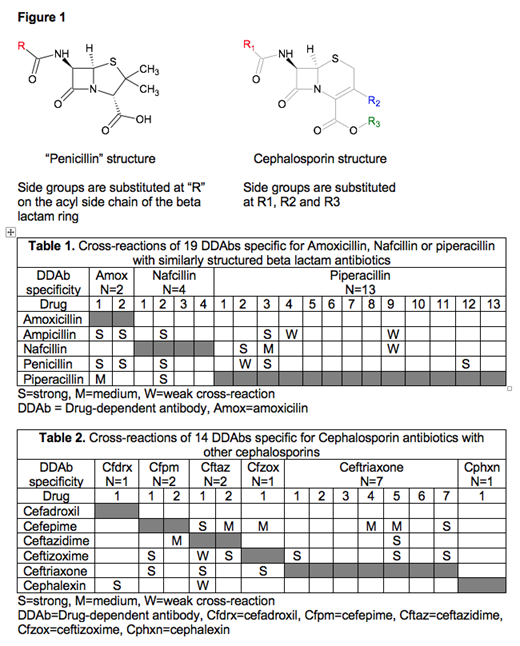More than 50 beta lactam (BL) antibiotics are now in active use for treatment of a wide range of bacterial infections. BL antibiotics are among the most common drugs capable of inducing antibodies (DDAbs) that cause drug-induced immune thrombocytopenia (DITP). Most DDAbs are highly specific for the sensitizing drug but beta lactams all have a common core structure and many similarities among side groups that are added to augment potency and modify specificity, raising the possibility that a DDAb specific for one BL may cross-react with another. We studied DDAbs from 33 patients with DITP induced by 9 commonly used BL drugs to determine whether patterns of cross-reactivity exist that might influence the choice of an alternative antibiotic in a patient with BL-induced DITP.
DDAbs were demonstrated in a flow cytometric assay considered to be "positive" when immunoglobulins in patient serum but not normal serum react with normal platelets in the presence, but not in the absence of drug (Blood 2018;131:1486). DDAbs detected in the 33 patients were specific for 9 different BL drugs that were divided into two groups, "penicillins" (Group 1) and cephalosporins (Group 2) on the basis of structural similarities (Figure 1). In Group 1 were 19 DDAbs specific for amoxicillin (2), nafcillin (4) and piperacillin (13). Structurally similar ampicillin and penicillin were also tested with these abs. In Group 2 were 14 DDAbs specific for cefadroxil (1), cefepime (2), ceftazidime (2), ceftizoxime (1), ceftriaxone (7) and cephalexin 1). Cross-reactions identified within these groups of DDAbs are shown in Tables 1 and 2.
Cross-reactions, many quite strong (S) were observed among DDAbs specific for drugs in both structural groups (Tables 1 and 2). Particularly noteworthy were cross-reactions of the 19 Group 1 DDAbs with ampicillin (6) and penicillin (6) (Table 1) and of the 14 Group 2 DDAbs with cefepime (6), ceftizoxazole (6) and ceftriaxone (3) (Table 2). The findings show that platelet-specific DDAbs induced by beta lactam antibiotics, in contrast with those induced by medications like quinine, sulfamethoxazole and vancomycin, commonly cross-react with other antibiotics of this class. In patients with immune thrombocytopenia induced by a beta lactam antibiotic, it may be prudent to avoid switching to another beta lactam or, if this is necessary, to monitor platelet counts carefully.
No relevant conflicts of interest to declare.
Author notes
Asterisk with author names denotes non-ASH members.


This feature is available to Subscribers Only
Sign In or Create an Account Close Modal